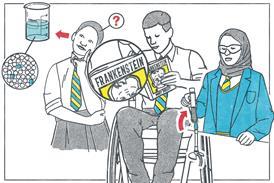Guided, active and purposeful practicals help build more confident learners and develop soft skills

Over the years, I’ve noticed that when and how to use Avogadro’s constant crops up frequently in lessons and often causes confusion. I wondered if a more visual representation might help clarify pupil understanding. I saw a few posts on X (formerly known as Twitter) showing water tension on an object’s small surface which sparked an idea. With help from microchemist extraordinaire Bob Worley, I developed a simple quantitative practical using a dropping pipette see Bob’s YouTube video (bit.ly/4mv5wZC). Inadvertently I’d created a guided, active and purposeful (GAP) practical – inspired by the University of York Science Education Group’s research.
Over the years, I’ve noticed that when and how to use Avogadro’s constant crops up frequently in lessons and often causes confusion. I wondered if a more visual representation might help clarify pupil understanding. I saw a few posts on X (formerly known as Twitter) showing water tension on an object’s small surface which sparked an idea. With help from microchemist extraordinaire Bob Worley, I developed a simple quantitative practical using a dropping pipette (see Bob’s YouTube video). Inadvertently I’d created a guided, active and purposeful (GAP) practical – inspired by the University of York Science Education Group’s research.
Guiding an active, purposeful practical
Before the practical, I make sure learners are familiar with the equipment, Avogadro’s constant and calculating the number of moles of a substance. To start, I ask pupils to predict how many drops of water might fit on a coin and challenge them to justify their answers. Depending on the group, I might guide discussion towards intermolecular forces and touch on the idea of water tension. I find that a picture of water droplets clinging to a leaf works well as a prompt.
Opportunities to play devil’s advocate crop up as well. I challenge learners to consider if drop sizes might vary if I used a syringe or teat pipette instead of a dropping pipette. In retrospect, having these to hand for students to compare the apparatus more easily might help guide initial conversations further. This is also a good opportunity to ask questions about accuracy and precision to develop their critical thinking. These simple prompts help guide the discussion away from simply counting drops of water.
I find a demonstration helps focus students on how to use the equipment – how to tare a balance, avoid air bubbles with a pipette and so on. Again, I guide the conversation with careful questioning … might your technique using the chosen apparatus impact your results? If they answer yes, I challenge them to explain how. You’d be amazed at how many pupils jump in to contribute here. The demonstration and questioning encourage an active, minds-on approach.
When I first trialled this GAP practical, the learners suggested turning it into a competition. They agreed the rules: everyone used the same type of coin, the aim was to fit the most water molecules on it and they had to show all their mathematical processing for peer review. The level of active engagement, even among my most apathetic learners, was glorious to observe.
Benefits of using GAP
While the goal of the practical was to boost student confidence in using Avogadro’s constant, the task offered wider benefits. With a simple method, a demonstration and small working groups (four or less), I had the time and flexibility to observe discussions and ask probing questions. I saw pupils reflect and refine their ideas. One learner said, ‘No disrespect to the Queen, but her head’s kind of big and it’s pushing the water away from a flat base to build a water bubble. I reckon we should have used the tails side.’
The practical gave pupils confidence with everyday lab equipment and reinforced how and when to use Avogadro’s constant. It also opened the door to extension questions, such as: how might the intermolecular forces change if you used a different liquid?
My experience with GAP is still developing, so I can’t yet comment on its long-term impact. However, the short-term benefits were obvious almost immediately: greater engagement, more confident learners and the unintended consequence of improved soft skills.
I now plan to embed GAP principles in our curriculum. I expect they will be particularly powerful when tackling more involved required practicals, like investigating energy changes, or abstract concepts like equilibrium. Whatever the context, minding the GAP clearly benefits everyone involved.
Lisa Niven
With thanks to Bob Worley, chemistry advisor at CLEAPSS, for his support and feedback while developing this practical.
Additional information
The author would like to thank Bob Worley, chemistry advisor at CLEAPSS, for his support and feedback while developing this practical.











No comments yet